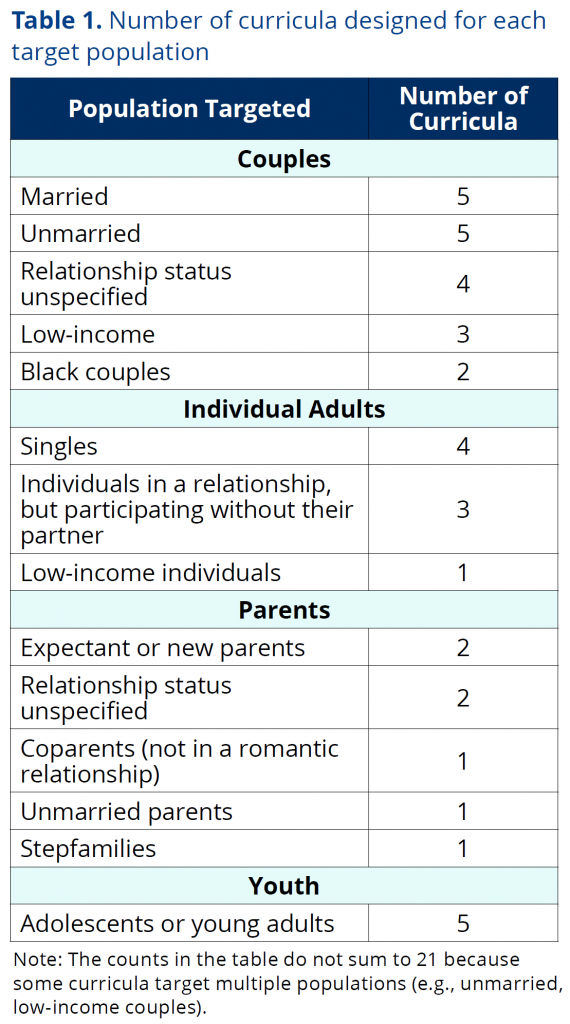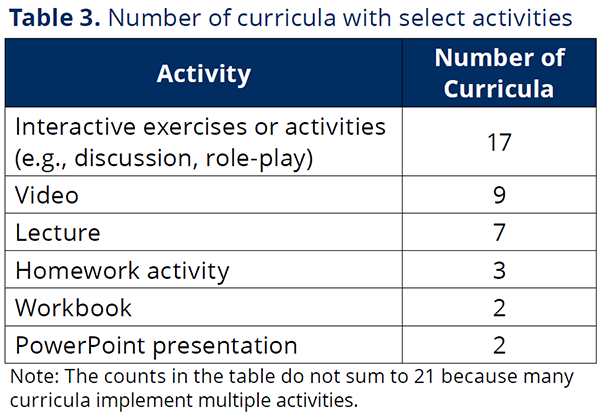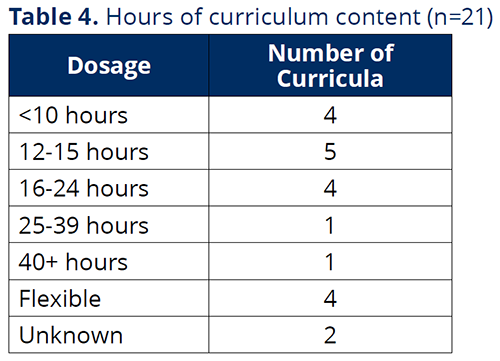An Overview of Healthy Marriage and Relationship Education Curricula
Healthy marriage and relationship education (HMRE) programming—also called marriage and relationship education or relationship education programming— teaches concepts and skills that promote healthy, safe, and stable relationships among youth and adults.1 When designing and implementing an HMRE program, one of the most important decisions that program providers must make is to choose which curriculum to implement. For example, organizations can use curricula developed by external developers that come with predetermined content, materials, and activities, or they may develop their own curriculum. With either approach, organizations need to consider many factors when assessing whether a specific curriculum is appropriate for a given program: For example, does the curriculum content align with the goal of that program, and is it designed for the program’s target population?
To help HMRE program providers (and the evaluators who work with them) better understand and assess various aspects of HMRE curricula, this brief provides an overview of the design of HMRE curricula implemented in programs that have been formally evaluated.a Synthesizing information from 21 HMRE curricula, the brief describes the target population(s) for which each curriculum is designed, the HMRE-related topics it addresses, any specific curriculum adaptations available (e.g., is it available in Spanish?), how the curriculum is delivered (activities), the recommended dosage of the curriculum, and whether facilitator training is needed implement the curriculum. The brief also discusses implications for future research and practice to improve the design and implementation of HMRE curricula. Appendix A provides a more detailed summary of each curriculum. An HMRE Curriculum Assessment Tool has also been developed to further assist program staff in selecting appropriate curricula.
Key Findings
- The HMRE curricula included in this review were most commonly designed for married and/or unmarried adult couples or adult individuals.
- Many HMRE curricula have been adapted for use with particular sub-populations targeted and served by HMRE programs—for example, low-income couples or individuals in the military. However, relatively few of the curricula reviewed were initially designed for these populations.
- The topics included in specific HMRE curricula often align with the unique needs of their target populations, but most address conflict management and communication.
- Establishing consistent and research-based core components (topics and activities) could improve HMRE curriculum delivery and facilitate replication in different settings and with different populations.
- Some curricula offer training to facilitators, and some require that facilitators be certified before delivering the curriculum. Incorporating more such formal staff training and assessing the quality of these trainings could improve overall delivery of HMRE curricula.
Methods
For this brief, the research team first identified HMRE implementation and program evaluation studies conducted in the United States, written in English, and published between 2008 and 2019. We searched multiple research databases using the search terms “healthy marriage and relationship education,” “couple relationship education,” “marriage education,” and “relationship education.” In addition, we reviewed the bibliographies of select articles and relevant websites to identify additional studies for inclusion. This review identified a total of 127 HMRE program implementation- and evaluation-related publications.
To capture more commonly used curricula, we focused on curricula that were implemented in at least two programs with published implementation or outcome evaluation studies. Based on these criteria, we identified 21 distinct curricula evaluated in 93 of the 127 reviewed publications. We obtained detailed information on each curriculum from the reviewed studies when available, combined with a scan of curriculum websites. If additional information was needed, we ordered complete curriculum manuals and materials and/or facilitator training materials, and consulted directly with curriculum developers when full manuals were not available.
All curricula were reviewed and coded using a standard coding scheme that consisted of the following fields:
- Target population: Information about whom a curriculum is designed for and/or receives the curriculum
- Topics: HMRE-related content covered in a curriculum
- Adaptations available: Information about ways in which a curriculum has been modified for use with specific populations other than the original target population or in different settings than originally designed
- Activities: Information about ways in which curriculum material is delivered
- Dosage: Information about the number of hours of curriculum material and/or the frequency of sessions
- Staff training options and requirements: Information regarding training requirements that familiarize facilitators with curriculum material to prepare them for delivering the curriculum
This brief was created by the Marriage Strengthening Research & Dissemination Center, a partnership between Child Trends, the National Center for Family & Marriage Research at Bowling Green State University, and Public Strategies.

HMRE Target Populations
HMRE curricula are designed for a variety of target populations. The curricula we reviewed were designed to explicitly serve (a) adult couples, singles, or both; (b) specific sub-populations of adults defined by characteristics such as socioeconomic status, race/ethnicity, or parental status; and (c) youth. Often, a particular curriculum focused on more than one target population (see Table 1).
The HMRE curricula reviewed were primarily developed for use with adult couples and adult individuals. Some curricula designed for use with adult couples specify that they target married couples (5 curricula) and/or unmarried couples (5), while others do not specify relationship status beyond “couples.” Three curricula were developed specifically for use with low-income couples.
Of the 21 curricula reviewed, two were designed for Black couples (Exploring Relationships and Marriage with Fragile Families; Basic Training for Couples). No other curricula specified that they had been developed for use with a specific racial or ethnic population.
Additional curricula included in this review were designed specifically for use with adult individuals: PICK (Premarital Interpersonal Choices and Knowledge) a Partner was developed for use with individuals who are not in a relationship (i.e., single), and Within My Reach was designed for use with individuals who may or may not be in a relationship, but who participate without a partner. Individuals can participate in OurRelationship alone or as a couple (as long as they are in some type of current relationship).
A subset of adult-serving curricula was explicitly designed for parents and/or expectant parents. Several HMRE curricula were designed for use with parents, including couples expecting their first child (Becoming Parents Program), unmarried couples with a child in common (Love’s Cradle) or expecting a child (Loving Couples, Loving Children), and stepfamilies (Smart Steps or Stepfamilies).
Five HMRE curricula were explicitly designed for use with youth. Within this group of youth-focused curricula, the target age ranges vary. For example, Relationship Smarts PLUS 4.0 is most often used with adolescents ages 12 to 16, and Love Notes 3.0 is most often implemented with individuals ages 14 to 25. One curriculum, PICK (Premarital Interpersonal Choices and Knowledge) a Partner, specifies that it can be used with single individuals of any age, from adolescents in middle school through the elderly.
21 HMRE curricula reviewed
- Active Relationships
- Basic Training for Couples
- Becoming Parents Program (BPP)
- Connections: Dating and Emotions
- Connections: Relationships and Marriage
- Couple Communication
- Exploring Relationships & Marriage with Fragile Families
- Hold Me Tight
- Love Notes 3.0
- Love’s Cradle
- Loving Couples, Loving Children
- Mastering the Mysteries of Love
- OurRelationship
- PICK (Premarital Interpersonal Choices and Knowledge) a Partner
- Prepare/Enrich Relationships Assessment
- PREP (Prevention and Relationship Enhancement Program)
- Relationship Smarts PLUS
- SmartSteps for Stepfamilies
- Together We Can
- Within My Reach
- Within Our Reach
Topics Covered in HMRE Curricula
Most HMRE curricula address conflict management and communication. Other topics that are important for healthy relationships but less commonly addressed in HMRE curricula include intimacy and friendships; empathy; commitment; negotiation and compromise; self-care; finances; and roles, values, and beliefs.2 A list of all topics included in at least two curricula reviewed here are listed in Table 2.b
- The topics most commonly addressed in the curricula reviewed include conflict management and resolution (in 15 curricula) and communication skills (14).
- Additional topics that are addressed less often but highlight other goals of some HMRE programming include stress recognition and management (5 curricula), finances (5), emotional regulation (2), understanding one’s partner (2), and expectations and reality of relationships and marriage (2).
The topics included in specific curricula often align with the needs of their target populations. For example, PICK (Premarital Interpersonal Choices and Knowledge) a Partner, a curriculum developed especially for singles, emphasizes how to ‘pace the development of a new relationship’ and ‘areas to pay attention to when getting to know a partner.’ Curricula designed for adolescents and young adults, such as Relationship Smarts PLUS 4.0 and Love Notes 3.0, include content on planning for the future, dating violence, sex education, and the impact of technology (e.g., social media and sexting). The Smart Steps for Stepfamilies curriculum, aimed at building healthy relationships and stable stepfamilies, focuses on communication with both current and previous partners (as coparents) and parenting stepchildren in addition to shared children.

The inclusion of specific topics in a curricula—as well as the strategies and materials used to deliver that content—is often research-based; that is, inclusion is informed by the broader scientific research on relationships.3,4,5 Many of the curricula reviewed here are informed by specific theories and/or scientific findings.
For example, Hold Me Tight is a streamlined version of Emotionally Focused Couple Therapy (EFT), a short-term structured couples therapy approach that focuses on creating and strengthening the emotional bond between couples. EFT is theorized to create these secure bonds by helping partners recognize their emotions and learn to express them through positive, rather than negative, interactions.6
Another example is Loving Couples, Loving Children, which is informed by research indicating that relationship supportiveness, while relatively high at the time a couple’s first child is born, decreases dramatically in the five years following their transition to parenthood.7 This was also the motivation for the development of a curriculum called Bringing Home Baby that was designed for expectant parents to mitigate declines in relationship supportiveness following the birth of a child. Loving Couples, Loving Children is similar to Bringing Home Baby but tailored to meet the needs of a low-income population.
The Active Relationships curricula center around a core set of skills, including communication and conflict resolution skills, abuse prevention, mindfulness, and goal setting. The development of these skill sets was highly influenced by cognitive behavioral theory and research on positive psychology, emotional intelligence, and marital stability (Active Relationships curricula developers, personal communication, December 16, 2019).
Adaptations to HMRE Curricula
Curricula are often designed for use with a particular population or for delivery in a certain format (e.g., in-person workshops). However, the original design may not be suitable for all populations or formats. As a result, developers and programs will often make adaptations to an existing curriculum so that it can serve a wider range of populations or be delivered in a different format. We found information regarding adaptations for approximately half of the curricula included in this review.
A culturally responsive adaptation tailors the original curriculum material to make it more relevant to the characteristics and needs of a specific population.8 This review includes curricula that have been adapted to better serve Hispanic/Latino couples, military singles and couples, men who are incarcerated or reentering society after incarceration, and even partners facing cardiac disease (see Appendix A).c These adaptations modify some curriculum activities and tailor them for the sub-populations of interest. For example, the Becoming Parents Program has a Hispanic/Latino version that builds on the original curriculum and incorporates values and norms of Hispanic/Latino culture. Relationship Smarts PLUS has a Sexual Risk Avoidanced adaptation that adds material to the original curriculum to better meet the requirements for Sexual Risk Avoidance funding.
Many curricula have been translated into languages other than English for use with non-English-speaking populations. Of note, a translated curriculum may be identical to the English version and therefore not considered an adaptation. However, translation allows non-English-speaking populations who may benefit from participation in an HMRE program the opportunity to do so. Nearly half of the curricula (n=9) have been translated into Spanish and a few have been translated into Mandarin and Korean. Hold Me Tight has been translated into 16 languages, making it available for use with many non-English-speaking populations.
Another way in which curricula have been adapted is for online delivery. For example, Hold Me Tight and PREP have been modified to be delivered online, making the curricula accessible to a larger audience. Participants complete these curricula independently, on their own schedules, and in the comfort of their own homes, which may eliminate common barriers to participation such as lack of transportation and conflicting work schedules.9
Some curricula provide explicit guidance on allowable and unallowable modifications. It is common for curricula to have core components, which are select topics, activities, or implementation approaches that are the most essential aspects of the curriculum.10 Allowable adaptations enable programs to alter elements of the curriculum that are not considered to be core.11 For example, Love Notes 3.0’s Evidence Based Program Model (EBP) adaptation includes add-on material, such as 1) activities for expecting and parenting teens; 2) icebreakers; 3) changes in the length, number, and frequency of sessions; and 4) make-up sessions. It does not, however, allow providers to implement the curriculum without using specific materials provided by the developer (e.g., PowerPoint slides, participant journals) or to skip any topics or activities from the core model.12 In addition, facilitators must receive appropriate training to deliver this adaptation of the curriculum.

Activities: Delivery of HMRE Curricula
HMRE curricula use a mix of activities and modes of delivery, ranging from lectures and facilitator presentations to interactive and participatory activities at the group, couple, or family level. This section provides an overview of how curricula content is delivered, and the types of activities used.
The most commonly implemented activities are interactive activities, viewing of videos, and lectures (see Table 3). Most curricula reviewed include some type of interactive activity. These activities can be group-based or couple-based. Another common activity is watching videos. In Loving Couples, Loving Children, facilitators show a weekly video of a curriculum developer interviewing a low-income couple about the week’s topic. These videos are intended to stimulate discussion among participants. One third of curricula include a lecture component, and a few include homework activities, workbook activities, or PowerPoint presentations.

Dosage of HMRE Curricula
Dosage in the context of HMRE programs refers to the amount of time needed to implement the full curricula to cover all topics and activities. This can be defined in terms of total hours or total sessions. We were able to locate this information for 19 of the 21 reviewed curricula.
Implementation dosage varies widely across HMRE curricula, ranging from five 50-minute sessions (approximately 4 hours total) to 21 2-hour sessions (approximately 42 hours total) (see Table 4). The majority of curricula have a dosage of 24 hours or less.
Some HMRE curricula offer flexibility in terms of the number of hours needed to deliver the complete curriculum. For example, Within My Reach includes 16 units that are approximately two hours each. Programs can deliver these units flexibly, using anywhere from one to all 16 units. Therefore, implementation can be as short as two total hours or as long as 32. A few curricula provide options for material to be delivered in short weeknight sessions for multiple weeks or in a fewer number of longer sessions on the weekend.
Staff Training and Training Resources
HMRE program facilitators need to be trained on the curriculum (topics, structure, and activities), engaging participants, and delivering the material with fidelity and quality. Fidelity refers to the degree to which all major elements of a curriculum or program are delivered as intended or designed.13 Quality is a measure of the skill or competence with which facilitators deliver the program and interact with participants.14 Information on facilitator training was available for 18 of the curricula included in this review.e
Fourteen curricula reviewed required some form of facilitator training, three had no training available, and one had an optional training available. Among those that do offer trainings, training generally lasts one to four days.
Detailed information on the content of the trainings was available for some curricula. For example, training for both Connections curricula include an overview of the curriculum, an in-depth examination of each lesson, hands-on use of the curriculum’s essential teaching tools, and examples of the flexibility of curriculum implementation. Exploring Relationships and Marriage with Fragile Families offers a two-day training in which facilitators observe trainers implementing modules of the curriculum while staff role-play as couples. Facilitators then practice implementing a session in the same setting and receive feedback from the trainers.
Two curricula offer facilitator training in person and online. PICK (Premarital Interpersonal Choices and Knowledge) a Partner requires that facilitators be certified via in-person or online seminars. After attending one of these seminars, facilitators must pass an online certification test. Similarly, the developers of the Prepare/Enrich Relationships Assessment—an assessment of relationship satisfaction, relationship dynamics, commitment level, personality, spiritual beliefs, and family systems—offer both in-person and online trainings. During these trainings, individuals learn to administer the assessment, interpret results, give feedback, generate discussion, and facilitate relationship skill-building exercises.
Some curricula also offer resources to staff throughout implementation. In addition to requiring that facilitators obtain certification, Love Notes 3.0 EBP, for example, offers resources for program providers and their facilitators, including slide decks related to the key content of the curriculum, fidelity measures for coaches and evaluators, and measures of facilitator quality.
Implications for Research and Practice
Drawing from a sample of curricula that have been part of evaluation research conducted over the last decade, the findings in this brief show that curricula developed for use in HMRE programming vary widely in terms of their target populations, HMRE-related topics, available adaptations, and training approaches. Our findings also point to some continued research needs to further inform HMRE practice. Below, we provide recommendations for curriculum developers, HMRE program providers, and evaluators to improve future HMRE program design and implementation.
More curricula need to be developed and evaluated that are designed for understudied groups who may be the focus of HMRE programs, but for whom relevant, tailored, and research-based curricula are lacking.
The target audience for many curricula is couples, both married and unmarried. Some curricula have been modified to better meet the needs of specific populations, including low-income couples, individuals not currently in a relationship, and non-native English speakers. Despite these existing adaptations, however, few of the evaluated curricula were initially designed to specifically meet the needs of these populations. More culturally relevant, tailored, and research-based curricula are necessary to meet the needs of the wide range of HMRE program attendees.
One promising model comes from the Hispanic Healthy Marriage Initiative (HHMI), a federal initiative to support delivery of effective, culturally appropriate marriage and relationship education programs to Hispanic communities across the country.15 Through this initiative, the HHMI developed a series of supplemental curriculum modules that can be used to enhance existing healthy marriage curricula and focus discussions on issues that are targeted and specific to the experiences of Hispanic couples and families. An implementation evaluation of programs funded by the HHMI demonstrated that several participating programs developed their own tailored curricula for Hispanic families;16 however, the effectiveness of these modules was not tested through a formal outcome evaluation.
Youth are an important target population for relationship education programs,17 and several curricula included in this review were developed for use with adolescents or young adults. However, this and other reviews18 show there is less research on these youth-focused curricula compared to those for adults. This includes more limited research on the theoretical motivations for youth-focused relationship education programs,19 the implementation approaches that are most appropriate for serving youth versus adults,17 and the long-term effectiveness of youth-focused programs.20
When implementing an HMRE curriculum, program providers should actively consider whether the curriculum goals, activities, and intended outcomes align with programmatic goals and target population(s). When evaluating a program using a particular curriculum, evaluators need to ensure that the evaluation design and data collection instruments are appropriately tailored to assess the intended outcomes of the curriculum and program.
When considering topics to cover, HMRE program providers should consider the ultimate goals of their program, as well as who they plan to serve. The topics most commonly addressed by the HMRE curricula reviewed here were conflict management and resolution skills and communication skills. However, curricula designed for specific populations may need to include unique topics. For example, in this review, we identified a curriculum designed for use with adolescents that included content on ‘planning for the future’ and a curriculum designed for singles that included content on ‘building new relationships.’
A unique topic for couples could be relationship fidelity and commitment. Although these two domains of relationship quality are often conceptualized as part of a healthy relationship,21 they were not common topics addressed by the curricula reviewed here, and relatively few evaluations of HMRE programs examine outcomes related to fidelity and commitment.22 This disconnect between the goals of a program for couples (e.g., couples stay committed to each other) and the content of its curricula may lead to gaps in our knowledge about the effectiveness of programs.
Establishing consistent and research-based core components (topics and activities) could improve HMRE curriculum delivery and facilitate replication in different settings and with different populations.
Although flexibility in the implementation of curricula can be valuable, guidance from curriculum developers on what topics and activities are required (core components) versus which are optional is not always available. For example, given challenges in participant retention, it would be useful for HMRE program providers to know whether a multi-session curriculum can be shortened by omitting some topics and/or activities and, if so, which ones. Additionally, identifying core components that are particularly useful or relevant for specific populations (e.g., youth, stepfamilies, etc.) could also be useful when programs seek to adapt curricula.
Curriculum developers may specify their core components as part of a logic model or theory of change, but sometimes specific components are named as core without any clear justification or research to support these requirements.11 Evaluators can help empirically confirm the core components of a curriculum; however, formal testing of core components can be difficult and costly.11
Incorporating more formal staff trainings into the guidance available for HMRE program providers and assessing the quality of these trainings could improve overall delivery of HMRE curricula.
Staff training is critical to ensuring that curricula are implemented as intended. Sufficient training equips staff to deliver a curriculum’s core components with a high degree of quality and fidelity to the model.23,11 As discussed above, most curricula in this review offer some amount of training, although not all include formal, required trainings. Two actions could improve overall delivery of HMRE curricula: (1) Curriculum developers could incorporate more formal staff trainings into the guidance available for providers, and (2) evaluators could assess the quality of these trainings in future HMRE implementation evaluations. When possible, curriculum developers should consider offering in-person trainings to program staff who want to use their curriculum, as these provide an opportunity for trainees to interact with trainers and see how the curriculum is implemented in practice.5
Practice Tips
Selecting an HMRE curriculum is vital to the success of your program and should include a careful assessment process, including a review of the key curriculum features described in this brief and how a curriculum aligns with the following characteristics of your organization:
- Target population(s)
- Program or logic model, including facilitator and training capacity, workshop format and location, etc.
- Budget
- Integration with other content
- Research/evaluation needs
Please see the HMRE Curriculum Assessment Tool for a list of questions that may help you assess your program needs and compare to available curricula.
Conclusion
This brief summarizes key features of HMRE curricula that have been the focus of recent program evaluation research. The brief is not an exhaustive inventory of all HMRE curricula, but provides details about a range of HMRE curricula developed for individuals (adults and youth) and couples that participate in HMRE programs. An HMRE Curriculum Assessment Tool provides additional guidance for HMRE program providers on using the information provided in this brief to assess the alignment of existing curricula with the needs and goals of organizations that aim to promote healthy and stable romantic relationships through HMRE programming. Additional recommendations are made for curriculum developers and evaluators to consider in their work with HMRE program providers.
Footnotes
a We limit our review to curricula that have been used in HMRE programs that have been formally evaluated in terms of how they were implemented (implementation or process evaluation) or their effects on participant outcomes (outcome evaluation). However, the current brief focuses on the design of HMRE curricula rather than on the implementation of these curricula in practice or on their effectiveness in achieving a program’s desired outcomes.
b See Appendix A for complete lists of topics covered in each curriculum.
c Not all adaptations described here were evaluated in the studies identified in this review.
d The Sexual Risk Avoidance Education Program funds programs that teach youth how to voluntarily refrain from nonmarital sexual activity. For more information, see https://www.acf.hhs.gov/sites/default/files/fysb/fysb_srae_gd_factsheet_020819b.pdf
e OurRelationship does not use facilitators and therefore training is not applicable for this curriculum.
Acknowledgments
About the Authors
About the MAST Center
References
© Copyright 2025 ChildTrendsPrivacy Statement
Newsletter SignupLinkedInYouTubeBlueskyInstagram
